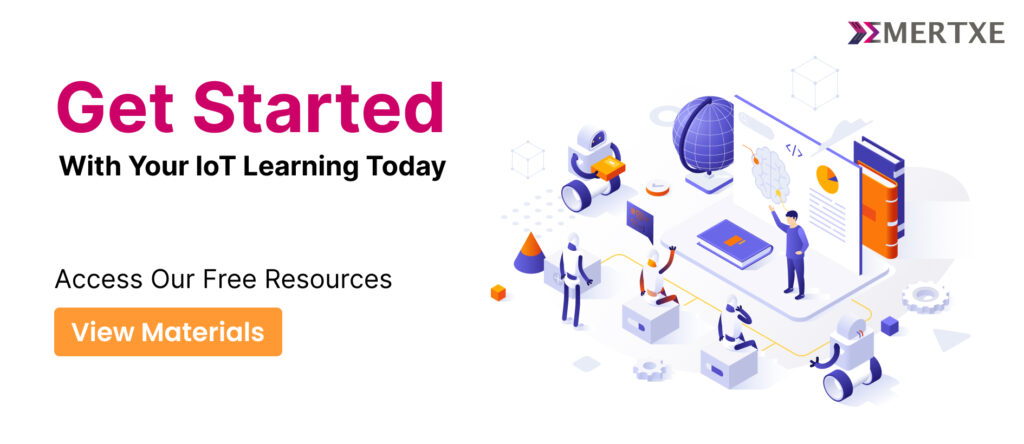The IoT Buzz
In this era, Internet of Things(IoT) is the buzzword!
Any conference or any technology journal or any meetups, one just can’t ignore talking about IoT. Having said that, as a fresher there is always a set of questions that pops up in your mind: How do I start learning IoT? This question further details into:
IoT is having too many technologies. Where to start?
How to build Projects on IoT on my own?
What type of hardware and software resources do I need?
Well, there is no definite answers for few questions as it is very subjective. Hence, based on our experience in Emertxe we would like to give you five steps to get started with Projects on IoT.
Before we get there, let us try to briefly understand IoT, which will come in handy while building Projects on IoT.
Introduction to IoT
To give a brief introduction, IoT is an organization of physical things embedded with sensors, electronics, software that are accessible through the internet. These physical things can be anything
which includes home appliances, automobiles, industrial machines, human body, transport vehicles, medical equipment or any other “thing” that you can think of. The number of Internet of Things (IoT) devices worldwide is forecast to almost double from 15.1 billion in 2020 to more than 29 billion IoT devices in 2030.
In 2030, the highest number of IoT devices will be found in China with around 8 billion consumer devices. IoT devices in the consumer segment are consumer internet & media devices such as smartphones,
where the number of IoT devices is forecast to grow to more than 17 billion by 2030.
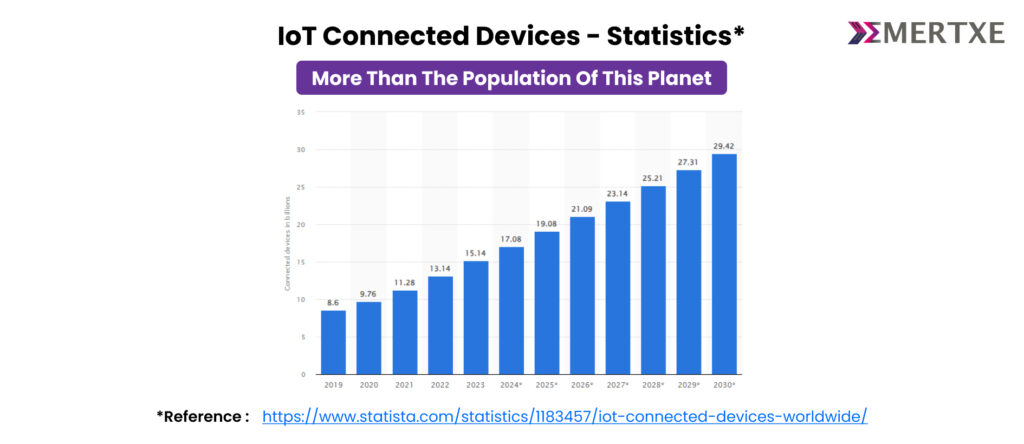
By building Projects on IoT, you can really understand what IoT is all about. You will get a clear picture of the technology and also build a wonderful career as there is a boom in the IoT job market.
IoT Architectural Overview
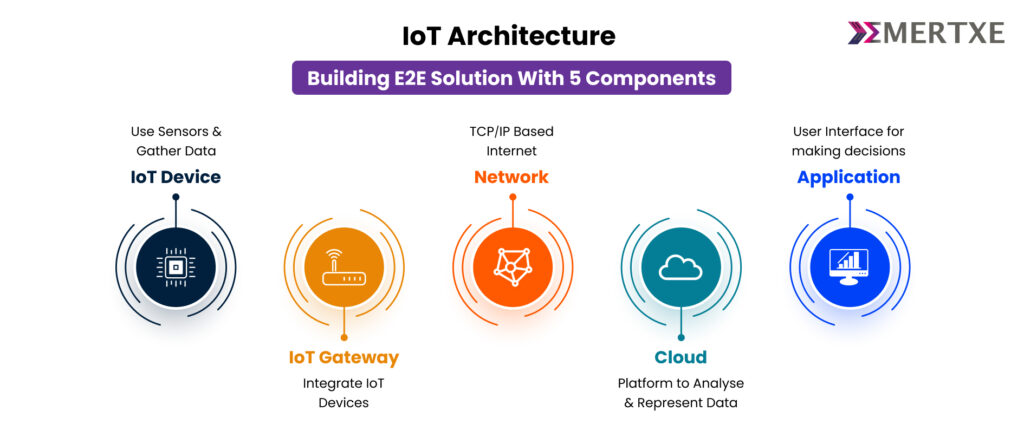
IoT architecture is a structure of numerous elements. In simple words, IoT architecture has five major components. They are described as follows:
IoT Device
IoT devices can be a combination of wireless sensors, software, actuators and computer devices.They are fixed to a specific object that runs through the internet. These devices enable the transfer of data among objects or people automatically without any interference of human resources.
For example, Fitbit is an IoT device that communicates with an app through internet and provides us with many insights about our health.
IoT Gateway
IoT gateway is a device or a software program that serves as a connection point between cloud and multiple IoT devices. All the information moving to the cloud or vice versa has to pass through the IoT gateway.
IoT gateway provides extra security for the IoT network and the data that is being transported. An array of IoT devices connect with IoT gateway via low-range protocols (ex: Bluetooth Low Energy or BLE).
The gateway in turn uses web-scale standard protocols (ex: Message Queue Telemetry Transport or MQTT) to access the internet. Some of the commonly used protocol information is given below.
Network
Network is the bridging element that connects an array of IoT gateways to the Cloud platform by traditional TCP/IP network. It has been existing over years connected with a suite of protocols.
Now the same network has an indeed meaning of being “glue” that bridges everything (IoT device, IoT gateway, Cloud and application eventually).
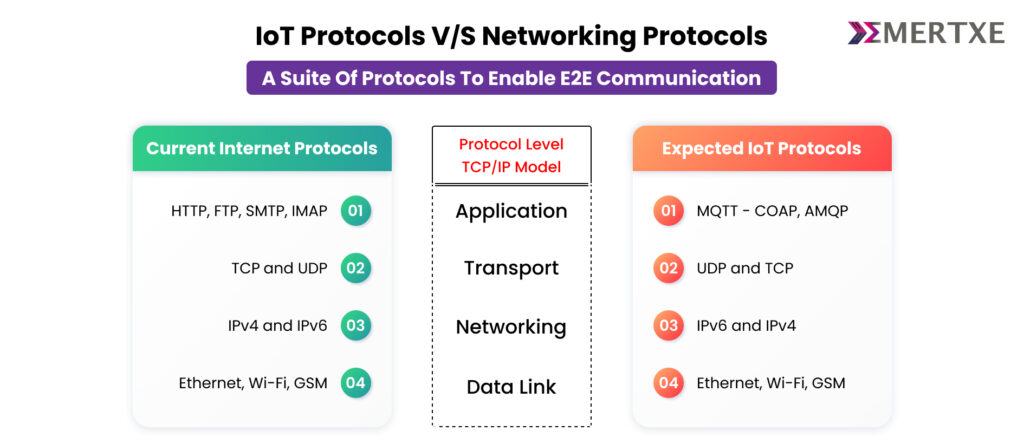
Cloud
Cloud is a platform that takes a huge volume of data generated. They receive them through IoT gateways which in turn have tons of devices behind them. Since the amount of data handling is very significant it will have following characteristics.
- Web services – Ability to handle incoming client request and response
- Scalability – Ability to scale-up or scale-down depending on the data / network traffic
- Distributed – Inherently support distributed computing to handle resources
- Business Intelligence / Analytics – By analyzing big data and derive analysis
- Cost optimization – Provide facilities to customer to achieve results in optimized way
Today almost all the most important giants like Google, Amazon, Microsoft,IBM are offering their own IoT platforms. All of them provide key features mentioned above and much more
Application
The synthesized data for the end user to derive meaningful insights. The application typically provides an User Interface (UI) which the user can get the final insights (ex: Home devices status) or even trigger some action (ex: Switch ON / OFF). Again this interface can be anything ranging from a mobile application, custom dashboards on panels or simply a web interface.
How to Build IoT Projects?
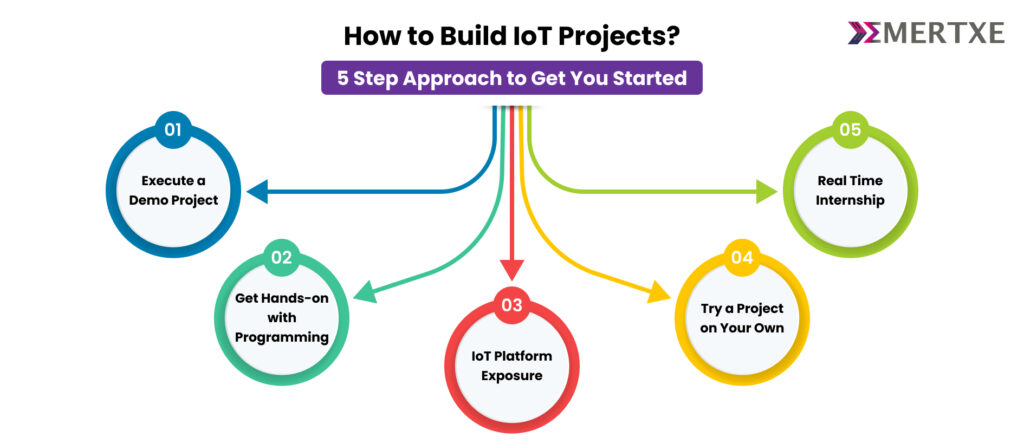
With this background information, let us answer the question ‘How to build IoT projects?’.At Emertxe, after handling 60,000+ students in the past 15+ years of existence, we always believe the best way to learn is by building projects.
Here are the top-5 practically implementable steps to have your own project working.
Step-1: Execute a Demo Project
To get the real taste of IoT, the first step is to execute a project which is already built by somebody. There are various websites to guide you with projects. For example: Hackster, EngineersGarage, Circuit Digest, Seeed Studio and many more.
It is always important to execute a demo project as it gives a clear idea for building your own IoT project. In particular, there are multiple “cool” projects that are available on these websites (ex: In Hackster – IoT home security model, IoT pet feeder) which will also give you a fun feeling while building them.
As you may observe, these projects also require a certain set of hardware and software to execute them. Thanks to Open Source, most of the software is available for FREE and downloadable from the links given for specific projects.
However choosing the right hardware kit / components always plays an important role in your project. There are some websites exclusively for the purchase of the components like Rhydolabz, Element14, which you can check out and make the right hardware purchase.
Step-2: Get Hands-on with Programming
The real use-case building of IoT happens due to an Engineer’s programming mind.
So it’s very important to know at least one programming language very well. The reason that IoT is a cross-disciplinary subject, we would recommend you to learn two programming languages that can come in handy that is C programming and Python programming.
C programming: In spite of so many programming languages available today, C is the most preferred language for programming Embedded Systems. Getting invented during the 1970s, the C programming language has evolved a loT.
Advanced C programming constructs like Pointers, Dynamic memory allocation, Data structure, User Defined Data structures, File operations etc. C programming unifies all the controllers and computing devices in the market. You will build strong capability and confidence in yourself in order to convert a given problem statement into a working program.
Similar to C Programming, learning Python plays an important role in skilling yourself for IoT. Python, a language akin to Perl, is an object-oriented programming language. Its preference among developers arises from its robustness.
Python boasts various features; it’s open source, portable, flexible, and embeddable. The language is efficient, fast, and supports various programming paradigms. Being a versatile interpreted language, Python is easy to learn, complemented by a rich set of libraries.
Curious about diving into the world of Python and IoT? Explore our Python Program study materials. Let Python be your catalyst for success!
About our Resource Library
In Emertxe’s Technical Resource library, You will find technical resources like Embedded interview questions and answers, Course materials, PDF’s, Videos, Sample Programs, Projects, Job based Interview Questions in technology domains like Embedded Systems, Linux, Internet of Things (IoT) etc.
Primarily Emertxe mentors contribute and create these contents. Our placement team also works very closely with our mentors to create company specific preparation materials. Our goal is to ensure the latest contents are shared via this library with our students and larger ecosystem.
Some of the links for programming languages are given below, from where you will have access to all the necessary resources for your learning.
Course Name | Links |
Advanced C Programming | |
C++ Programming | |
Python Programming | |
Basic Linux Shell Scripting |
Step-3: Get Hands-on Platform Exposure
After all, gaining hands-on programming we are sure your logical and analytical skills will improve and make a huge positive jump. At the next step you need to gain hands-on experience with any popular IoT platform.
It’s important to realize that there are a lot of them available already. From team Emertxe’s side we have been doing quite a lot of work on the GR Lychee platform (created by Renesas Electronics) as part of the GR Lychee annual IoT design contest.
There is a wonderful hands-on video prepared by one of our mentors which will help you to get started. By understanding such a platform you will be able to program an Embedded System for a specific IoT use-case. Of course you can look out for many similar resources on the web!
Step-4 : Try a Project on Your Own
It is always very challenging to try out an IoT project on your own. But most importantly that’s the only way to learn! Now that you have all the fundamental elements required you can start working on a project on your own.
Again, Emertxe’s Technical Resource comes in handy when it comes to trying projects. Before you start on your main IoT project, you can explore some projects based on C programming and Microcontroller Programming.
Following is a set of hand-picked projects in terms of increased complexity. These projects have requirement specifications, expected output and reference materials mentioned in those respective projects. By utilizing these projects you should be able to build on your own.
- Image Steganography Using LSB Mechanism : Bits of unused data are replaced by bits of valuable information using LSB mechanism. Sender and receiver will have individual key / secret based on which they will be able to extract the actual data from the image. This project also gives a basic level understanding of image processing methodologies.
- Car Black Box (CBB) Implementation : Black Boxes are typically used in any transportation system (ex: Airplanes) that are used for analysis post-crash and understand the root cause of accidents.The goal of this project is to implement core functionalities of a care black-box in a PIC based microcontroller supported by rich peripherals. Events will be logged in EEPROM in this project. This project can be further extended to any vehicle.
- Industrial Machine State Monitoring System :The Industrial Machine State Monitoring System (IMSMS) Arduino project aims to enhance factory efficiency by monitoring critical machine health indicators. It retrofits existing machines, tracks parameters like temperature, pressure, noise, and vibrations, enabling data analysis. This empowers operators to take corrective actions, optimizing machine life and performance. Perfect for beginners diving into Arduino projects!
- Street Light Control and Monitoring : The IoT cloud project aims to address the increasing demand for electricity and environmental concerns. By installing devices on streetlight poles, it monitors lighting activity, sending data to the cloud for analysis. This efficient solution helps conserve energy and allows remote control of streetlights. A smart approach to tackle power usage issues!
Step-5 : Get Real-time Experience
When it comes to gaining real time experience, we strongly recommend students to explore internships.
Internships act as a great source for you to build real-time projects.
In order to make a difference in the internship ecosystem and bridge the gap between industry and academia in India, Emertxe, in 2021, initiated a free internship for engineering students. These internships focus in the fields of Internet of Things (IoT) and embedded systems.
Emertxe Internship is a complete package where we provide selected interns with the complete set of resources – offer letter, study materials, mentor guidance, evaluation tests, and completion certificates. Certificate showcases the comprehensive hands-on project work that participants do through the program.
When it comes to our internship, they mention of it being a graded adventure, with quizzes, and real time project output as milestones, adds a clear and engaging touch. As mentioned above, the program takes an immersive approach for participants in a rigorous, hands-on experience, guided by highly experienced mentors.
The internship adopted a comprehensive approach, combining training in product development using the Software Development Life Cycle (SDLC) methodology. Critical thinking skills were emphasized as students developed and implemented their embedded applications.
Apart from technical skills, our internship focuses on the softer side of career development. The DISHA workshop series addressed essential aspects such as resume preparation, interview skills, and overall career building. Check out the ppt given below
Conclusion
IoT is a huge platform to work on! As a fresher, you should definitely explore and work on some IoT projects. In order to build projects you require some foundational skills followed by domain skills. Working on IoT projects not only benefits to build your career but also taps your creative side of your brain.
A huge opportunity is waiting to be harnessed; go ahead and grab them with both your hands. Why don’t you start building an IoT project right away? Also do check out IoT Internship from Emertxe
| SN | Related Blogs | Links |
|---|---|---|
| 1. | Online Free IoT Internship for Engineering Students | Free Certificates |2023 | Click Here |
| 2. | How IoT Programming Requires More Foundational Skills? | Click Here |
| 3 | What Are the Best Courses in IoT Programming? | Click Here |
People Also Ask(PAA)
Yes, you got it right! There are several open-source platforms for developing IoT projects including Node-Red, OpenHAB, Home Assistant etc which provide various advantages such as easy integration, support for various devices, rule engines for automation, user-friendliness, and active community development.
In the current IoT job market, high-demand skills include Programming language, data analytics, cybersecurity, networking etc. To acquire these skills individuals can pursue online courses, workshops, and certifications. Practical, hands-on projects and real-world where Emertxe stands best for providing courses, internships in Embedded and IoT domains.
Nest Labs, Particle, and C3.ai. Nest Labs revolutionized home automation, Particle facilitated rapid prototyping and spurred IoT innovation, while C3.ai transformed energy and healthcare industries through AI-driven solutions.
IoT contributes to smart cities by enhancing efficiency in services like traffic management, waste disposal, and energy consumption. Challenges for widespread implementation include cybersecurity concerns, interoperability issues, and the need for robust infrastructure.
To thrive in an IoT career, essential skills include proficiency in programming, understanding hardware-software integration. Emertxe Provides hands-on experience in embedded systems, programming, and IoT applications, ensuring participants develop the necessary skills for a successful career in IoT.
